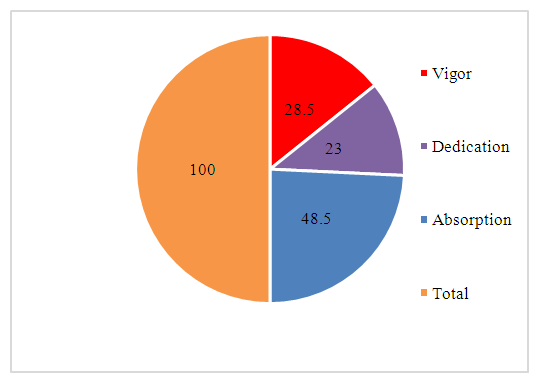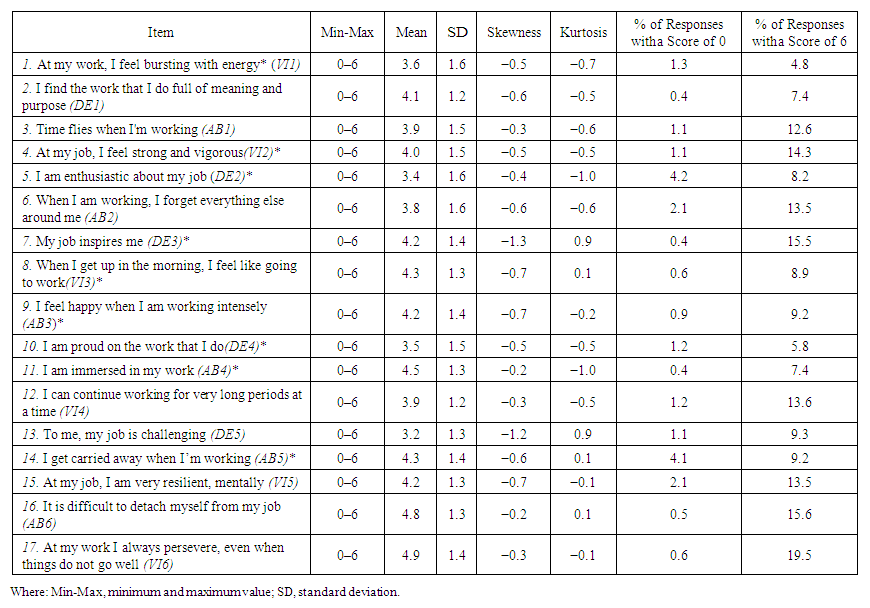-
Paper Information
- Next Paper
- Previous Paper
- Paper Submission
-
Journal Information
- About This Journal
- Editorial Board
- Current Issue
- Archive
- Author Guidelines
- Contact Us
American Journal of Medicine and Medical Sciences
p-ISSN: 2165-901X e-ISSN: 2165-9036
2023; 13(12): 2002-2006
doi:10.5923/j.ajmms.20231312.39
Received: Nov. 28, 2023; Accepted: Dec. 13, 2023; Published: Dec. 23, 2023

Analysis of the UWES-17 Scale in Children's Hospital Nurses (Tashkent City)
Dildora S. Tulyaganova1, Fatima B. Tashxodjaeva2, Feruza L. Azizova3
1Doctoral Student of Tashkent Medical Academy, Tashkent, Uzbekistan
2Senior Lecturer of Tashkent Medical Academy, Tashkent, Uzbekistan
3Vice-Rector of Tashkent Medical Academy, Tashkent, Uzbekistan
Correspondence to: Dildora S. Tulyaganova, Doctoral Student of Tashkent Medical Academy, Tashkent, Uzbekistan.
| Email: |  |
Copyright © 2023 The Author(s). Published by Scientific & Academic Publishing.
This work is licensed under the Creative Commons Attribution International License (CC BY).
http://creativecommons.org/licenses/by/4.0/

Assessment on the Utrecht scale is widely used internationally, but it was first analyzed using the example of multidisciplinary pediatric hospital nurses (Tashkent City). This study aims to study how psychologically connected, analyzing the degree of involvement in the work.
Keywords: Utrecht scale (UWES-17), Nursing care, Children's hospital
Cite this paper: Dildora S. Tulyaganova, Fatima B. Tashxodjaeva, Feruza L. Azizova, Analysis of the UWES-17 Scale in Children's Hospital Nurses (Tashkent City), American Journal of Medicine and Medical Sciences, Vol. 13 No. 12, 2023, pp. 2002-2006. doi: 10.5923/j.ajmms.20231312.39.
1. Introduction
- In different countries, the level of involvement in the work of a nurse using the Utrecht Jackal analysis has been carried out with research work [1,2,3], of which (Sara Domínguez-Salas, 2022) analyzed the psychometric characteristics of the Utrecht (UWES-9) scale in a sample of active medical personnel during the pandemic.Mansour Torabinia and others (2016) took into account the general trend of psychology toward the effective and optimistic experiences of employees in the field of work and organizational psychology at work, for example, in the process of work: assessing and finding psychometric characteristics of the Utrecht work involvement scale have observed in nurses as part of a study that there is any conducted an element response theory analysis of the Japanese (Tsubakita, Shimazaki et al. 2017) version of the Utrecht case involvement scale for students in the student nurse sample, assessing the parameters of difficulty and discrimination. Employment involvement affects many factors, among them revealing the quality and effectiveness of work and the degree of job affiliation among dental nurses (Wang et al.). In 2021, a study using the example of 215 dental nurses in China found that recruitment was positively correlated with social support, psychological flexibility, and subjective well-being but was negatively correlated with stress at work—all of these psychological variables explained together with 34.7% of the disparity in employment [1].In this case, it is important to analyze nurses in children's hospitals who seek treatment for various diseases. Caring has been proven to directly impact the quality of interactions [4]. If the general trend of psychology were taken into account [5], researchers in the field of labor and organizational psychology will gradually be able to see an interest in the productive and optimistic experience of employees at work. For example, in addition to burnout, the researchers focused on his ideas about overtime [6]. As for the impact of the quality of the healthcare system on people, especially on the health of children, it has been proven that the development of this system is important for each of them. Among the medical staff, nurses make up a significant part of the medical staff. Hospitals are an ongoing goal with the need to achieve better patient outcomes combined with sustained economic growth. Studies of high-performance organizations say success is achieved when engaged employees actively solve problems related to their productivity. In addition, it was found that an increase in nurse engagement rates has a greater impact on patient outcomes than an increase in the number of nurses [7].In particular, many factors affect engagement, such as family [8], the person [9], work experience [10] and the diet [11]. This result may be due to external needs such as nurses, manpower and resource shortages, conflict with patients or their families, or aggression [12].This is probably due to a more complex professional environment and stress at work among medical workers than people of other professions [13]. In turn, stress causes strong exhaustion. To reduce fatigue, it is very important to make some changes to the characteristics of the work, to increase the connection with the work of nurses, and, most importantly, to assess the effectiveness of these changes. This requires reliably proven scales [14,15] and a high level of work involvement can improve the performance of nurses and reduce satisfaction and emotional health and turnover [16]. According to Schaufeli and Bakker, for example, from other scholars, engagement is described as power, dedication, and absorption. Strength is defined as a high level of strength and psychological tolerance during work. Potential consequences involving work related to optimistic views include job and organizational job satisfaction, while low interest lies in organizational commitment and turnover [17]. Employment varies across occupations: teachers, managers, artisans saw a high rank, nurses, salesmen, and farmers, while a low rank was found among conveyor workers, retailers, machinists, domestic workers, and police officers [18] influencing factors recruitment involves factors related to work and individual factors. Work-related factors are divided into categories of four domains: stress factors at work (aspects of work required). important mental and physical strength), labor resources (work aspects that stimulate personal development and help achieve work goals), work psycho-social emotions (emotional and mental results of employees from work), and work results (performance indicators). Individual factors are divided into three areas: demographic, individual health (mental, psychological, and physical health), and individual factors (external factors). work). Several factors have been reported to depend on the level of recruitment. Engagement is the result of personal education (i.e., sensitivity, thinking) and the work environment [19], the work environment can play a more important role in the engagement. Some studies have concluded that stress at work is positively related to working [20], while other studies have found opposite results, that is this work. Stress is negatively associated with working [21,22]. Psychological flexibility [23], perceived social support [24] and subjective well-being [25] the case was found to be related.Although some literature indicates that the decrease in nurses' involvement in childbirth is caused by a lack of energy, this is mainly due to working with sick children and their loved ones, and low involvement in work, which leads to a decrease in the quality of nursing work and patient satisfaction. The study of labor relations between nurses and related factors for the recruitment of nurses in Uzbekistan is useful for nursing managers to provide effective organizational assistance and improve the recruitment of nurses is an area that has not yet been sufficiently studied.
2. Aim
- Analysis of the UWES 17 scale in nurses of the multidisciplinary Children's Hospital of Tashkent and study of the degree of its connection with stress at work.
3. Materials and Methods
- The material for the study was obtained from 92 nurses (n-92) working in a children's multidisciplinary hospital in Tashkent. During the study, the nurses were tested for the Utrecht jackal. The Utrecht Recruitment Scale (UWES 17) was used to assess the level of energy and mental endurance during work of nurses who agreed to participate in the study, as well as the importance of work, inspiration, pride, complexity and concentration. A comprehensive evaluation questionnaire survey of parents and relatives of sick children was conducted in order to study the level of satisfaction with the quality of the nurse's work.
4. Results
- Before analyzing the work of a nurse at a children's hospital, we studied information about the patient population.The new children's hospital, built during the quarantine period of 2020, accepts sick children with various pathologies all year round. The hospital consists of 12 departments with 240 beds. The total number of nurses is 283, and the number of doctors is 160. If we look at the indicators of children who seek help, for example, in 2022, a total of 7899 children applied, of them under the age of 1-1242 (15.7%), under the age of 5-4138 (52.3%), and under the age of 14-2518 (31.8%).The hospital employs 283 nurses, of which 92 (n-92) nurses participated in observation and research work. Of these, 100% were women, with the highest age index being 39.1% aged 30 to 39 years. Of these, 16.3% were nurses with higher education, while all nurses were women (Table 1).
|
 | Figure 1. UWES-17: vigor, dedication, absorption, and total value index in percentiles |
 | Table 2. Analytical Statistics of the UWES-17 |
5. Discussion
- In this study, children's hospital nurses on the Utrecht 17 scale were counted on the recruitment scale. In some literature, the one-factor structure in its analysis required confirmation, and the results showed that there was a common factor [3,27]. In others, it was recommended by previous studies on UVES-17 for the confirmation of these elements [28]. Many factors influence the recruitment characteristics of the contingent we have learned, such as family [8], person [9], work experience [10] and nutrition diet [11]. If we look at the literature, a study on employment among 3,887 Portuguese workers (50% nurses, 39% firefighters and 11% police) showed that firemen had the highest job, with work, nurses being the least engaged. [26]. This result is due to external influences in which the nurse suffers from a lack of manpower and resources, frequent conflict with patients or their families, or aggression [12] occurrence. Another study 1,330 nurses are listed among 10 general hospitals (> 500 beds) with employment scores among nurses vigour (3.21), dedication (3.44) and absorption (2.73) indications [8].Although this study was conducted at the largest children's hospital in the capital, it is a prestigious center, which is a large and multidisciplinary sample in Uzbekistan. Given that the work of the center's nurses has a direct impact on the work of the hospital, which receives the most children, one more necessary information has yet to be determined to improve the representativeness.
6. Conclusions
- The study supports the feasibility of using UWES 17 in the work of nurses in children's hospitals. Engagement was positively related to work engagement in terms of energy, commitment, and engagement. Even to know the level of psychological stress in nurses' work, the result of the analysis allowed us to understand the relationship between mental health at work. Social support, psychological flexibility, and subjective well-being were found to be negatively correlated with job stress. Increased work stress itself led to decreased engagement. And also between healthcare providers and allows organizations to propose specific strategies to improve these factors. Nurses' level of mental health naturally means that their work can improve the quality and quality of life of sick children, which will lead to a reduction in the number of accidents.
 Abstract
Abstract Reference
Reference Full-Text PDF
Full-Text PDF Full-text HTML
Full-text HTML